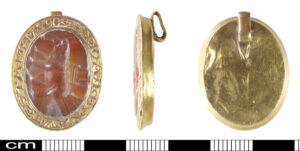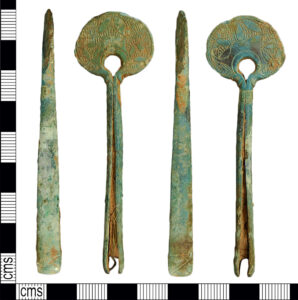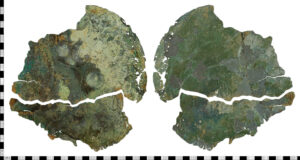Preliminary Treasure figures for recent years are currently 1,311 for 2019 and 1,077 for 2020. The latest complete Treasure Annual Report, covering finds made in 2018, was released in March 2021, announced by Caroline Dinenage MP, Minister of State for Digital and Culture and the British Museum. This report showcases that 1,094 cases were reported Treasure in 2018, consisting of over 20,906 individual artefacts. 347 of these cases were acquired by 108 different museums. An overwhelming majority of these (93%) were acquired by museums local to the findspot, meaning that most finds retain their local context by staying in the area close to where they were found. 22% of these acquiring cases have seen one or more interested party generously waive their reward, making it much easier for local museums to acquire these finds for public benefit without the need for fundraising. More than 96% of Treasure finds in 2018 were found by metal-detectorists.
At the end of last year, the Government published its response to the public consultation on changes to the Treasure Act 1996. Under the changes, a new definition of treasure will be developed which will take into account the historical and cultural significance of a find rather than solely considering its material qualities.
To coincide with this report, the British Museum also announced more recent Treasure finds of significance. These objects, which finders have a legal obligation to report, will now go through the Treasure process and include a unique medieval meme of a “snail man”:

The “Snail Man” Mount
A quirky and unique medieval “snail man” mount (SWYOR-4E467E) from Pontefract, West Yorkshire, found in 2020, which may have been a form of medieval meme. Dating from AD 1200–1350, the mount depicts a human figure emerging from a snail shell on the back of a goat, of which no close parallel has been identified. The male knight wears a Norman style helmet with a long-sleeved tunic and one leg lunging forwards, suggesting the man is stepping out from the shell. The figure’s hands are pressed together as if in prayer, implying it has religious connotations. Depictions of snail combat are a mysterious medieval phenomenon – armed knights fighting snails are common in manuscripts from this period. Suggested allusions range from references to the Resurrection, to associations with a repentant thief and cowardice. It has also been thought this may also allude to a stigma against the Lombards, who were seen as cowardly and malicious in Northern Europe – the traditional “good versus evil” struggle is thereby reflected in the chivalrous knight fighting the slimy snail. The mount’s more comical fusion of snail and man remains unexplained by this theory. This could suggest that the original “good versus evil” meaning has mutated to satirical connotations, a cultural phenomenon that means we can see this mount as an early meme. Wakefield Museum hopes to acquire.
Beverley Nenk, Curator: Later Medieval Collections, said: “This unusual silver-gilt mount may once have been attached to a leather belt or strap, or perhaps worn as a badge. The image of the praying knight emerging from a snail shell atop a goat implies an element of parody or satire. Snails are often depicted in the margins of medieval illuminated decorated manuscripts and are thought to symbolise cowardice, and this may be the intended meaning. The mount may be a satirical reference to cowardly or non-chivalric behaviour of opponents in battle, or as a parody of the upper or knightly classes. As such, it demonstrates the humour often found in medieval material culture.”

Medieval Seal Matrix
Gold medieval seal matrix (NMS-CB2CBE) from East Walton, Norfolk, with a Roman intaglio engraved with an elephant carrying a castle or howdah on its back, discovered in 2020. This is the third such gold seal matrix to be recorded through the British Museum’s Portable Antiquities Scheme (PAS), showing how rare they are. Dating between AD 1250 and 1350, elephants appear in examples of early medieval art as a symbol of fidelity, gentleness, great strength and longevity, including Romanesque sculpture and Byzantine silks. The castle reflects the animal’s close association with the east, where Indians and Persians were said to use such structures to fight from in battle. A live elephant was present in the royal menagerie of Henry III at the Tower of London between 1255–1257 as a gift from Louis IX of France. The anonymous inscription reads PARMAT EST WEVEI DRA OBEST, likely meaning “armed with a shield, the outlaw dragon is harmful”, which suggests a mythic link between elephants and dragons – it was said that a dragon is an elephant’s only foe. Norwich Castle Museum hopes to acquire.
Beverley Nenk said: “This gold counter-seal, or private seal, would have been used to seal letters or documents, and demonstrated the wealth, status and education of its owner. The motif engraved on the gemstone is a rare portrayal of an elephant from the medieval period, which is found mainly on objects signifying wealth and status, such as carved ivory gaming pieces and heraldic badges. It is represented with a war-tower, or howdah, on its back, which subsequently became known as the ‘elephant and castle’ of heraldic iconography. Few people in medieval England would have seen a live elephant. The image may have been based on reports of these fabulous and exotic creatures from travellers or pilgrims returning from the East or from the Crusades, or from descriptions and images in bestiaries and other manuscripts.


Iron Age Objects
Various Iron Age objects (BH-72C17B) dating between 80 BC-AD 100, were found at Kensworth, Bedfordshire, including a decorated bronze mirror, a pair of tweezers, a pin and numerous fragments from bronze vessels, as well as a ceramic vessel. Incorporating items associated with both feasting and personal appearance, these are likely grave goods from a cremation burial. The polished bronze mirror is characteristic of the Iron Age in southern Britain, with only around 30 decorated examples currently known. The mirror is in several parts, comprising a handle and two substantial pieces of bronze sheet, which would have formed a kidney-shaped mirror plate. On the back, the plate is decorated in the European Iron Age La Tène style, comprising tear, fin, circular and trumpet-shaped motifs. The plain front of the plate would have been polished to create a reflective surface. The looped mirror handle is decorated with grooves and has a narrow, rectangular slot in which part of the mirror plate remains in situ. It is rare for tweezers from this period to be decorated, but the example from this find is engraved with three circles, each containing a basket-weave tricorn element dividing the circle into three. The circles are separated by basket-weave fin motifs, all within a plain border. The Culture Trust, Luton, hopes to acquire in due course.
Julia Farley, Curator: European Iron Age and Roman conquest period collections, said: “This assemblage likely represents the grave goods from the cremation burial of an important individual. The finds tell us about the care and attention to personal appearance in Late Iron Age Britain; the polished bronze mirror is a rare and exciting find, and the decorated tweezers are unique. The vessels may have been used for serving up part of a funeral feast, or perhaps they were to equip the deceased with food and drink for the afterlife.”

Bronze Age Hoard
A bronze rapier blade, measuring over half a metre long and broken into three pieces was found as part of a Bronze Age hoard (SUR-68C46E) from Stalbridge, Dorset. The bronze hilt has been modelled in imitation of a wooden one, and is highly unusual for a find from Britain, with only two other examples known, while other, similar, examples are from Ireland. The metal hilt allows us to appreciate how other, more common, rapier blades – a type of sword – would have looked when new. A fully intact copper-alloy bracelet, also rare, was found in the same hoard, decorated with engraved panels of complex geometric decoration. It is a type that is found in both southern England and the near Continent. The third object was a type of axe known as a palstave used in everyday tasks of woodworking and house building. The hoard dates to 1300–1100 BC, a period when the deposition of metal hoards increases in the south of the England.
Neil Wilkin, Curator: Early Europe collections, said: “Hoards of this type characterise a period of intensifying connections and contacts across Britain, Ireland and the near Continent associated with the trade and exchange of copper and tin. The rapier blade made of bronze rather than wood is a fantastic insight into the rich organic world that is so often missing from our appreciation of the deep past. It is not clear why the bronze smith chose to undertake the difficult and skilful task of casting the handle in metal, but it suggests that this blade had a particular symbolic importance and may have been designed to endure.”
PAS and Detectorists Are Key to Success
Caroline Dinenage, Culture Minister, said: “Treasure has captured our imagination for centuries and it is fascinating to see what has been uncovered each year. These discoveries contribute invaluably to the knowledge and understanding of our shared history and I am particularly pleased that so many will go on display in local museums around the country.”
Hartwig Fischer, Director of the British Museum, said: “Every year I am delighted that archaeological objects uncovering pieces of our history are still being discovered, which all contribute to our understanding of the past. It is pleasing to see that once again a significant number of Treasure finds are to be acquired by museums near to the findspot, retaining the local context that is often so important for these objects.”
Michael Lewis, Head of PAS and Treasure at the British Museum, said: “It is fantastic news that Treasure finds have been acquired by over 100 museums across England, Wales and Northern Ireland, with many ending up close to where they were found enabling local people to learn about the archaeology and history of their local area. Key to the success of the Treasure Act is the British Museum’s Portable Antiquities Scheme, with our local archaeologists in England working closely with local detectorists and other finders.”
These finds are recorded on the British Museum’s Portable Antiquities Scheme (PAS) database which holds information on over 1,521,000 objects, all freely accessible to the public. The Scheme records archaeological finds discovered by the public to advance knowledge and understanding of British history through research and furthering public interest in the past. Most are found by metal-detectorists and a responsible approach to searching finds in accordance with the Code of Practice for Responsible Metal-detecting helps preserve our understanding of these objects and enhance our knowledge of the past. The PAS is a partnership project, managed by the British Museum (in England) and hosted by the Amgueddfa Cymru – National Museum Wales (in Wales). It consists of 42 locally based Finds Liaison Officers (FLOs) with the Welsh Archaeological Trusts, whose job it is to record archaeological finds made by the public.
In July 2020 the Portable Antiquities Scheme reached the milestone of 1.5 Million archeological objects.
For more, follow the British Museum blog or visit their website.
In 2009, CoinsWeekly introduced the Portable Antiquities Scheme to its readers on the occasion of the PAS’s 20th birthday.
In 2014 PAS registered the 1-millionth object.
In the following year, PAS was threatened by financial cuts.
And most recently, the PAS reported that the number of Treasure finds made by the public hit a record level in 2019!




